WHEEL GUIDE
There are 4 main considerations to be taken into account when purchasing wheels to ensure they will fit on your vehicle. These are the bolt pattern or pitch circle diameter (PCD for short), the wheel offsets, the wheel widths and whether the car can be a square or staggered set up and lastly the hub bore of the car and center bore of the wheel. This seems more complicated than it actually is however we have only listed products that are a perfect fit for your vehicle according to factory specifications. All wheels we suggest or recommend for your vehicle are guaranteed by us to be a perfect fit for your vehicle and provide a vibration free drive - this means any issues as a result of our wheels, we provide a full refund. For more information on this, please view the Unique Money Back Guarantee page.
BOLT PATTERNS OR PITCH CIRCLE DIAMETER (PCD)
When it comes to finding the proper fitment for putting aftermarket or other new wheels on your car, the bolt pattern is possibly the most important consideration. There is a perfectly obvious reason for this,since “bolt pattern” refers to the number of lug holes in the wheel and the distance between them. The bolt pattern on the wheel must match the bolt pattern on the vehicle they are being fitted to, or the wheel will not fit. All BMW vehicles in the current line up have a bolt pattern of 5 holes x 120mm or abbreviated to 5 x 120. All Porsche vehicles have 5 holes x 130mm or 5 x 130. This means that BMW wheels will not fit on the wheel hubs of any Porsche.
The bolt pattern is comprised of two numbers - the first indicates how many bolt holes are on the wheel, and the other describes how far apart they are. A bolt pattern of 5-115mm would mean the wheel has five bolt holes and they are 115mm apart (measured across the center of the wheel).
We sell wheels with 4, 5, 6, and 8 bolt applications:
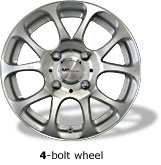
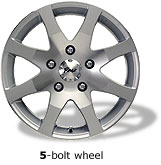
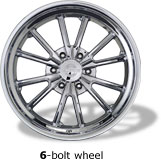
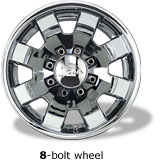
Dual or Universal Bolt Patterns: More and more manufacturers are building their wheels with two bolt patterns. This expands the number of fitments the wheel applies to. For example: a wheel with a 4-100/114.3 bolt pattern has 8 lug holes and will fit both 4 x 100mm and 4 x 114.3mm fitments.
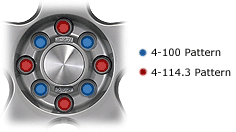
Measuring your Bolt Pattern
Measuring the 4, 6 and 8-bolt patterns: They are measured from the center of one lug hole to the center of the opposite hole.

Bolt measurement examples
Measuring a 5-bolt pattern: A 5-bolt pattern is very difficult to measure without using a bolt pattern gauge. Basically, you would measure the diameter of a circle that crosses through the center of the lug holes. This method is not recommended to confirm wheel fitment.

Bolt measurement
example
WHAT ARE WHEEL OFFSETS?
The offset of a wheel is what locates the tire and wheel assembly in relation to the suspension. More specifically, it is the measured distance between the hub mounting surface and the center line of the rim. Below is an explanation of the various types of offsets which are pictured in the above graphic.

Positive Offset
A positive offset occurs when the hub mounting surface is on the street side (the side you see) of the center line of the rim. Most factory rims will have this type of offset.

Zero Offset
When the hub mounting surface is centered within the rim, it is known as a zero offset.

Negative Offset
If the hub mounting surface is on the brake side of the center line of the rim, it is considered a negative offset or "deep dish".
Note that extensive negative offset can potentially cause increased steering wheel kick-back and place additional stresses on the vehicle's entire suspension
Please feel free to drop by or phone a store near you if you require additional facts about wheel offsets.
THE HUB BORE & CENTER BORE
The centerbore of a wheel is the size of the hole in the back of the wheel that centers it over the mounting hub of the car. Some factory wheels have a centerbore that matches exactly with the hub to reduce vibration by keeping the wheel centered. Wheels with the correct centerbore to the car they will be mounted on are known as hubcentric. Hubcentric wheels take the stress off the lug nuts, reducing the job of the lug nuts to center the wheel to the car. Wheels that are not hubcentric are known as lugcentric, as the job of centering is done by the lug nuts assuming they are properly torqued down.
Centerbore on aftermarket wheels must be equal to or greater than that of the hub, otherwise the wheel cannot be mounted on the car. Many aftermarket wheels come with "hubcentric rings" that lock or slide into the back of the wheel to adapt a wheel with a larger centerbore to a smaller hub.[5] These adapters are usually made of plastic but also in aluminum. Plastic rings only provide initial centering, but are not strong enough to help support the wheel in case of high speed pot hole hit. Steel ring is strongest, and aluminum is medium
